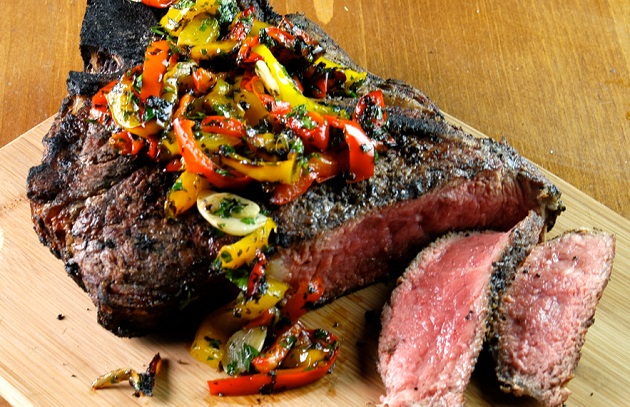Blog
7 Steps To Grilling Nirvana
Grilling is the world’s oldest and most universal cooking method, practiced in virtually every country and culture on six continents (seven if you consider the cookouts staged by grill-obsessed scientists in Antarctica).
Today’s grillers face a staggering number of decisions, from which grill and accessories to buy, to selecting the best fuel and cooking method. (There are actually five different grilling methods, each with its own unique cooking properties. And that’s before you get to specialized grilling techniques, such as plancha grilling and planking.)
Of course, you need to know about the rubs, marinades, brines, bastes, glazes, and other flavorings that transform simple grilled foods into live-fire masterpieces.
Finally, you need to know how to manage the food on the grill and cook it to the desired degree of doneness.
In other words, there’s a lot more to grilling than throwing that steak or chop on the grill. But don’t worry: I’ve got you covered.
Step 1: Choose Your Grill
“Which grill should I buy?” is one of the questions I hear most. Unfortunately, there is no one-size-fits-all answer. In general, if convenience is important to you, I recommend a gas or pellet grill or smoker. If you enjoy the process—then by all means acquire a grill fueled by wood or charcoal. Your available budget and space will factor into your decision as well. My general advice is to buy more grill than you think you’ll need. You can always grow into it as your skill set expands. (For concise information on every type of grill, including multi-fuel grills, see my book Project Fire.)
Step 2: Select Your Fuel
Since 1952 when Illinois metalworker George Stephens created the iconic Weber kettle grill, a “grate” debate has raged over which fuel is better: charcoal or gas. Then there’s the original—and to my mind, the best—wood. Master these three basic fuels and you can grill anything, anywhere, on any type of grill.
Step 3: Assemble Your Tools
A craftsman needs the right tools to complete tasks, and so does a serious griller. Here are what I consider indispensable tools:
- Tongs for turning the food and for cleaning and oiling the grill grate. (On my TV shows, you’ve likely seen me oil a folded paper towel, clasp it in tongs, and run it over the bars of the grill grate.)
- Wire grill brush/wooden grill scraper for cleaning your grill grate, which you should do religiously before your food goes on and after it comes off.
- Grill spatula for turning burgers, fish fillets, etc.
- Grill light for illuminating the grill grate during pre-sunrise or post-sunset cooks. Many models clip right only your grill, but headlamps are also effective.
- Grill gloves protect your hands and forearms from direct heat. Choose thick leather, Kevlar, or other aramid gloves.
- Meat thermometer, either remote or instant-read, for determining when food (especially proteins) is done.
- Chimney starter if your preferred fuel is charcoal. My Best of Barbecue chimney starter will hold nearly 100 charcoal briquettes.
Step 4: Flavor Your Food
Almost from the birth of barbecue, our prehistoric ancestors sought to enhance simple grilling by the application of seasonings, herbs, and spices. (Mustard seeds turn up at Stone Age campsites.) Salt and pepper are indispensable, but you can develop much more complex flavors when you introduce rubs, marinades, glazes, etc. See Sauces, Rubs, and Marinades for recipes.
Step 5: Choose Your Grilling Method
Direct grilling—cooking food directly over the fire—is the simplest, most straightforward, and by far, the most popular grilling method. But there are other methods that are better suited to particular foods. In addition to direct grilling (best for tender, thinner, fast-cooking foods like burgers, steaks, fish fillets, etc.), but indirect grilling is widely used for larger cuts like whole chickens, pork shoulders, prime rib, and other foods. Indirect grilling means you cook the food next to—not directly over—the fire. Indirect grilling is almost always done with the lid closed. Smoking (also called barbecuing) is actually a form of indirect grilling. (Check out Project Smoke for everything you need to know about this wildly popular cooking method.)
Of course, there is also spit-roasting—grilling on a rotisserie—a method that is ideal for cylindrical foods like whole chickens or ducks, pork loin roasts, prime rib, or even whole pineapples. And what I like to call “cavemanning,” grilling food directly in the embers. Cavemanning can be used on thick steaks or chops, lobster, and dense, sturdy vegetables like onions, yams, cabbage, peppers, and eggplant.
Step 6: Fire It Up
Lighting a grill is easy, even if you grill with charcoal. It takes 15 to 20 minutes to light charcoal in a chimney starter, and 10 to 15 minutes to preheat a gas grill. So the time difference is nominal. There are several ways to light charcoal or wood (see Project Fire); to light a gas grill, follow the manufacturer’s instructions. Make sure you always raise the lid before turning on the gas.
Step 7: Putting It All Together
Once you know how to choose your grill, source your fuel, assemble your tools, season your food, select a grilling method, and fire it up, the last step is to put it all together and get grilling.
Nearly any food you can think of can be kissed with fire or smoke, from breakfast eggs to desserts. I challenge you to cook an entire meal on the grill. It’s easier than it sounds, and is standard operating practice at my house. Build your menu using a mix of dishes you grill live and that you can grill ahead. Then you’ll have the opportunity to shine and to enjoy your own party. For specific tips, check out my blog.
Fuente: barbecuebible.com

